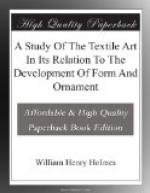[Illustration: Fig. 294. Basket showing ribbed surface produced by impacting the horizontal or concentric filaments. Moki work—1/8.]
[Illustration: Fig. 295. Alternation of intersection, producing oblique or spiral ribs. Piute work—1/8.]
[Illustration: Fig. 296. Radiating ribs as seen in flat work viewed from above. Moki work—1/4.]
It will be observed, however, that the ridges do not necessarily take the direction of the warp filaments, for, with a different alternation of the horizontal series—the woof—we get oblique ridges, as shown in the partly finished bottle illustrated in Fig. 295. They are, however, not so pronounced as in the preceding case. The peculiar effect of radiate and concentric weaving upon the ribs is well shown in Fig. 296.
By changes in the order of intersection, without changing the type of combination, we reach a series of results quite unlike the preceding; so distinct, indeed, that, abstracted from constructive relationships, there would be little suggestion of correlation. In the example given in Fig. 297 the series of filaments interlace, not by passing over and under alternate strands, as in the preceding set of examples, but by extending over and under a number of the opposing series at each step and in such order as to give wide horizontal ridges ribbed diagonally.
[Illustration: Fig. 297. Diagonal combination, giving herring bone effect.]
[Illustration: Fig. 298. Elaboration of diagonal combination, giving triangular figures.]
This example is from an ancient work basket obtained at Ancon, Peru, and shown in Fig. 299. The surface features are in strong relief, giving a pronounced herring bone effect.
[Illustration: Fig. 299. Peruvian work basket of reeds, with strongly relieved ridges.]
Slight changes in the succession of parts enable the workman to produce a great variety of decorative patterns, an example of which is shown in Fig. 298. A good illustration is also seen in Fig. 286, and another piece, said to be of Seminole workmanship, is given in Fig. 300. These and similar relieved results are fruitful sources of primitive decorative motives. They are employed not only within the art itself, but in many other arts less liberally supplied with suggestions of embellishment.
[Illustration: Fig. 300. Effects produced by varying the order of intersection. Seminole work—1/8.]
Taking a second type of combination, we have a family of resultant patterns in the main distinguishable from the preceding.
[Illustration: Fig. 301. Surface effect in open twined combination.]
[Illustration: Fig. 302. Surface effect of twined, lattice combination in basketry of the Clallam Indians of Washington Territory—1/8.]




